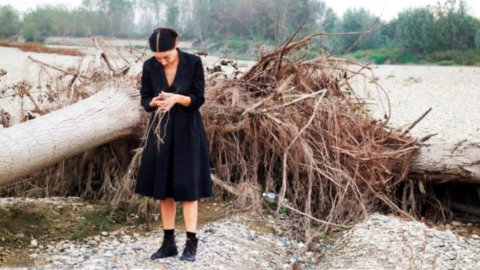From 8 September to 20 October 2016, the Italian Cultural Institute in London hosts the exhibition Raccontare il presente featuring the works of the Gallarate Prize, from the collection of the MA*GA Museum.
The review, curated by Emma Zanella and Alessandro Castiglioni, is part of a wider program that celebrates the fiftieth anniversary of the Gallarate museum and presents some of the most interesting results of the production and acquisition projects carried out on the occasion of the last three editions of the Gallarate Award, between 2009 and 2016, by artists such as Riccardo Arena, Luca Bertolo, Marzia Migliora, Luigi Presicce and Moira Ricci.
The project documents a series of practices characterized by a complex narrative attitude, from a variety of approaches ranging from the creation of context-related and site-specific works, to long-term research projects, to historical or biographical experiences.
The initiative is promoted by the Italian Cultural Institute in London as part of the project dedicated to the enhancement of contemporary artistic production developed in Italy. As Marco Delogu, director of the Italian Cultural Institute in London recalls, “the historical and contemporary characteristic of Italian artistic production is its diffusion and dissemination throughout the territory, even outside the capitals and large cities. In this perspective, cases such as Gibellina or Garavicchio are historical examples of which Gallarate with its prize and its museum is also an example".
The exhibition itinerary opens with the photographs of Moira Ricci (Orbetello, GR, 1977) taken from the series 20.12.53-10.08.04, a work born from an autobiographical idea. The artist builds her works through meticulous photomontages in which she, dressed in period clothes, fits into the photographs that have as protagonist her mother, who died prematurely. In the sequence of photographs that portray moments of daily life, the only constant presences are that of the mother, portrayed in different periods of her life, and that of Moira Ricci, always of the same age, despite the style adjustments, and always with a melancholy and resigned turned to his lost mother.
Then, we continue with the video by Luigi Presicce (Porto Cesareo, LE, 1976), The Burial of Adam, the first episode of the cycle The Legend of the True Cross. Presicce continues and deepens its constant work of re-reading traditional myths and stories through the creation of tableau vivant shot through video or photography. In this work, he draws on the legend of the sacred wood used for the construction of the Cross of Jesus, that of the tree grown on Adam's tomb that King Solomon had cut down for the construction of the Temple.
With Duplice Morte Ellero and Ecosistema Visivo, Riccardo Arena (Milan, 1979) reflects on the theme of identity and on how man is effectively able to define its nature. The installation is made up of different elements: photographs, archival materials, documents and conceptual maps. The central nucleus of the entire work revolves around an investigation which speaks of the disappearance of a mysterious character, who shot himself with the help of two revolvers that fired simultaneously, through a system that recalls the one devised by Umberto Ellero for the invention of mugshot photography, and disfigured his face, making it unrecognizable.
The exhibition continues with Gallarate Hardcore by Luca Bertolo (Milan, 1968) who, through 16 drawings, observed some microscopic aspects of the ecosystem of the city of Gallarate and of the naturalistic context linked to the river area around the museum, collecting, along the bed of the stream of the city, fragments of waste materials, organic finds, leaves, shells. These scraps became the subjects of a series of drawings: lyrical portraits reminiscent of the illustrations in XNUMXth-century naturalistic treatises.
The exhibition closes ideally with the video installation Made in Italy by Marzia Migliora (Alessandria, 1972) who, in recent years, has linked her activity to a broader research dedicated to the theme of work. In this particular case, the artist is interested in the industrial history of Gallarate, in its impressive textile production and in some aspects of its current crisis and reconversion. The image of degradation and suffering that the buildings abandoned by bankrupt companies bring with them goes hand in hand with the purification of the waters of the Gallarate stream, today no longer polluted by the industrial waste that colored the river waters almost daily and rehabilitated by a domestic fauna.
MA*GA and Gallarate Award
The MA*GA Museum is one of the most important Italian contemporary art museums, born in 1966, now owned by the Ministry of Cultural Heritage and Activities, endowed with a collection of over six thousand works, an exhibition space of five thousand square meters in Gallarate, a city halfway between Malpensa Airport and Milan and a second office in Legnano located in the historic Palazzo Leone da Perego.
The origin of the museum is linked to the Città di Gallarate National Visual Arts Prize, now in its twenty-fifth edition, founded in 1949 with the aim of establishing a contemporary art museum through the works acquired in the various editions of the Prize itself: this is how it was inaugurated the first edition on May 25, 1950.
In 1966, in conjunction with the eighth edition of the Gallarate Prize, the Civic Gallery of Modern Art was inaugurated which was moved and enlarged in 1973, and then expanded again in 2010 with the establishment of the MA*GA. In addition to the ordinary activity of the museum, in over sixty years the Prize has counted XXV editions, turning attention to the multiplicity of artistic languages, with a perspective that favors the investigation of the most significant contemporary expressions.
Among the latest editions we mention: Third landscape. Italian photography today (2009); Long Play (2012); Urban Mining/Urban Regeneration (2016).





